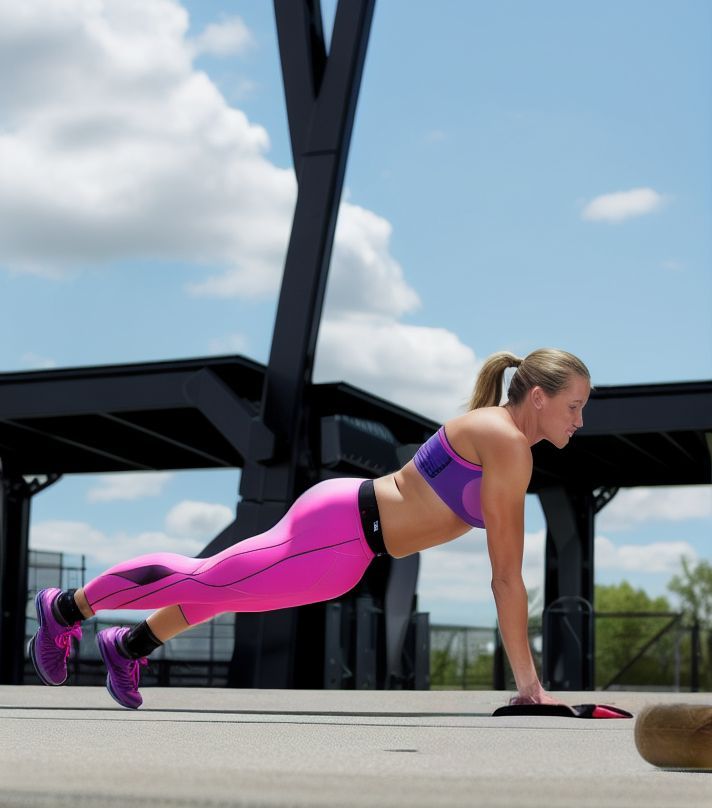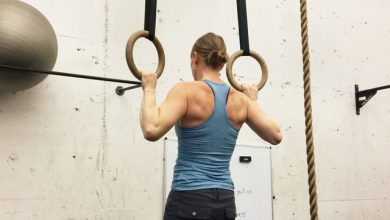A typical workout involves both eccentric (ECC) and concentric (CON) phases of the movement. We can also split these two phases and form an exercise based on either of them. Eccentric calisthenics training eliminates the concentric phase and performs solely on the eccentric phase.
Naturally, many daily activities involve only the negative phase of muscle contraction. A few examples: walking downhill, descending stairs, descending from a height like a ladder or a tree, and landing phase of jumping. On the other hand, some activities only involve positive phase, such as draining water out of well using a bucket and rope.
The idea behind eccentric calisthenics is to replicate those same natural movements and turn them into exercise. Exercises, such as negative push-ups, negative pull-ups, negative dips, and eccentric squats.
Eccentric calisthenics has been gaining popularity in recent years, and it is becoming an essential tool in the toolbox of any calisthenics athlete.
Table of Contents
What Is Eccentric Strengthening?
Eccentric strengthening is a strength training system that is based on eccentric exercises. So, it incorporates rules of strength and hypertrophy into negative phase workouts. Eccentric strengthening is an important tool for athletes and weightlifters looking to improve their performance.
It can help to increase power, reduce fatigue and improve muscular endurance. The key to success with this type of training is to focus on proper form and technique and to use progressive overload.
Eccentric strengthening is a way to fight against plateau and add variety to the routine. Performing negative phase exercise allows us to handle 130% to 150% of 1RM (one repetition maximum). This feature provides an extra stimulus for muscles to grow.
Related: Different types of muscle contractions in TRX suspension training.
Benefits of Eccentric Calisthenics Training
- Improved strength and muscle development: Eccentric training places a greater load on the muscles, leading to more muscle damage and an increased need for repair and growth. This can result in improved muscle strength and development.
- ECC consumes less energy and oxygen than CON, yet according to a study published by Wayne State University, eccentric workout increases the resting metabolism by 9%, which in turn leads to more weight loss.
- Calisthenics eccentric training can improve power and endurance. ECC involves a slower pace in the negative phase of the movement, which can help better develop endurance and strength.
- Increased range of motion: Calisthenics eccentric training allows starting the movement from the high-end, which we may neglect in standard mode. Also, studies show that ECC induces changes in the muscle’s structure. Improvement in the range of motion also helps with flexibility and mobility.
- Improved balance and coordination: Emphasis on the extension phase of movement improves the balance between opposing muscle groups. Eccentric calisthenics exercise can help develop a proportionate physique.
- Reduced risk of injury: A direct result of balance and coordination is reduction of the risk of injury.
- Improved athletic performance: Some sports demand better performance at the negative phase of the move. A simple example is when you jump or fall off from a height. Eccentric exercises are crucial for runners, and many yoga moves rely on the eccentric phase.
- Increasing intensity in bodyweight exercises: Calisthenics eccentric training can be great for adding intensity to the exercises without using weights. Extended time under tension during ECC and increased range of motion allow elevating intensity.
- Bodyweight Negative Training Instead of Positive Training. Sometimes we may not be able to perform the concentric phase of an exercise. This can be due to lack of strength or fatigue. We can perform those exercises by replacing positive rep with negative rep and gradually obtain the strength necessary to execute the positive phase.
Note that ECC stands for eccentric training, and CON means concentric training.
Calisthenics Eccentric Training for Rehabilitation
Bodyweight eccentric training can also be used for rehabilitation. It improves strength, flexibility, and endurance while reducing the risk of injury. Calisthenics eccentric exercise can be beneficial for those recovering from injury or surgery.
Bodyweight eccentric training can also be useful for individuals with chronic conditions, such as arthritis or osteoporosis, as it can help to improve muscle strength and function while also being low impact and easy on the joints.
Nowadays, many physiotherapists use TRX in their toolbox as an efficient method for rehabilitation, as it helps with muscle balance, stability, and range of motion.
It is important to consult with a healthcare provider or a trained exercise professional before starting any new exercise program, especially if you are recovering from an injury or have a chronic condition. It is also important to start slowly and gradually increase the intensity and duration of your workouts as you become more comfortable with the exercises. Proper technique and adequate resistance are also essential to avoid injury.
Please note that some of the links on this website are affiliate links, which means that we may earn a commission if you click on the link and make a purchase. This won’t cost you anything extra.
The compression bands are designed to improve joint mobility and neuromuscular mechanics. They aim to restore and activate live muscle tissue by promoting rapid blood flow to targeted areas. These bands also help reduce inflammation by compressing swelling out of joints.

Compression bands can be used during warm-up, throughout the workout, or for post-workout recovery. The product has been effective in alleviating elbow pain and providing stability for shoulder and knee issues.
Calisthenics Eccentric Exercises for Seniors
For the same reasons mentioned before, calisthenics eccentric exercises can be beneficial for seniors. If they have mobility issues or lack sufficient muscle strength for standard movement, negative repetition with bodyweight can be a workable substitute.
- Negative phase exercises are low impact, and they are easier on joints.
- Eccentric training requires less energy and oxygen consumption. They require less force than the corresponding standard exercises.
- Bodyweight eccentric movement can help to improve balance and coordination.
Naturally, the process of aging reduces aerobic capacity, muscle strength, and functional mobility. A review published by the University of Chichester considered ECC a promising exercise modality for older adults to improve their functional mobility.
6 Bodyweight Eccentric Training Methods

We can adopt many eccentric training methods of weight training to calisthenics workouts.
Here are a few different techniques that can be used in bodyweight eccentric training:
- 3–5 seconds eccentric tempo: This technique involves performing the negative phase of a bodyweight exercise by taking 3–5 seconds to complete the descent. This can help to increase muscle damage, which in turn leads to improvement in muscle strength and function.
- Super slow eccentric: This slow mode of bodyweight eccentric training can take 10–30 seconds. It is particularly suitable for long range of motion, such as in squats or chin-ups. It is excellent for the final part of a hypertrophy session. You can perform 1–3 reps with 30 seconds eccentric phase, or 4–6 reps with 10 seconds eccentric phase. Start with one set initially and build up to 3 sets over time.
- Eccentric isometrics: While performing the eccentric move, pause the movement at one to three predetermined points. Each hold can take 2 to 10 seconds. A common pause point is at the lower end of bodyweight eccentric move. These pauses increase time under tension and enhance strength and endurance.
- Eccentric overload: This technique, also called accentuated eccentric training, involves increasing the resistance during the lowering phase of a bodyweight exercise. This can be achieved by using a weighted vest, or other forms of added resistance, such as intelligent weight technique. This can help to increase muscle strength and power. The concentric part is explosive, or you may use the intelligent weight technique.
- Bilateral concentric–Unilateral eccentric: Start the concentric part using both limbs and perform it explosively. A momentary pause at the top of the movement to shift to unilateral. Perform the eccentric phase on one limb slowly.
- Forced reps: Perform 6–12 repetitions in standard concentric-eccentric mode until you reach failure. Then perform 1-3 more repetitions using assistance from the intelligent weight technique during the concentric phase and perform the eccentric phase unassisted.
Note: For a mere eccentric bodyweight workout, adjust the weight or the amount of pressure based on the eccentric phase and not the concentric phase. It is also important to use a slow and controlled tempo to complete the descent and to avoid swinging or using momentum.
A Few Examples of Eccentric Calisthenics Training
- Eccentric bodyweight chin-up. Eccentric bodyweight chin-ups involve focusing on the lowering phase of a chin-up movement. For ascending part, you may get assistance using different techniques.
- Eccentric bodyweight push-up. Start in a plank position, slowly lower your body towards the ground, taking 3–5 seconds to complete the descent.
- Eccentric bodyweight squat.
- TRX eccentric exercises, such as TRX eccentric chest fly, TRX eccentric row.






Related: Eccentric muscle contraction in TRX suspension training.
Effect of Concentric vs. Eccentric Training on Hypertrophy and Strength
Several studies have compared the effects of eccentric training to concentric training on strength and muscle development. Here are a few examples:
A systematic review published in the Journal of Sports Sciences concluded that eccentric training (ECC) may be more effective than concentric training (CON) for improving muscle strength and function in older adults. This study indicated that eccentric workout at higher intensities compared to concentric training increased both total strength and eccentric strength more significantly.
This study also suggested that the superiority of eccentric training in mass and strength development is related to handling extra load in eccentric contraction. In addition, eccentric training showed a tendency toward cross-sectional muscle development.
A study published in the Journal of Strength and Conditioning Research found that eccentric training resulted in greater muscle hypertrophy and strength gains compared to concentric training in young, healthy individuals.
A study published in the European Journal of Applied Physiology compared concentric-eccentric coupled (CON-ECC), eccentric-only (ECC) and concentric-only (CON) strength exercises for strength and hypertrophy.
| Group | MVC-ISO Increase | MVC-ECC Torque Increase | MVC-CON Torque Increase | MT Increase |
|---|---|---|---|---|
| CON-ECC | 12.0% ± 15.7% | 12.5% ± 18.3% | 17.5% ± 13.5% | 10.6% ± 5.4% |
| ECC | 11.3% ± 10.8% | 16.2% ± 11.0% | 14.2% ± 10.4% | 9.7% ± 7.2% |
- CON-ECC: Concentric-eccentric coupled contraction
- ECC: Eccentric-only contraction
- MVC-ISO: Maximum voluntary isometric contraction
- MVC-CON: Maximum voluntary concentric contraction
- MVC-ECC: Maximum voluntary eccentric contraction
- MT: Muscle thickness
This study, which was conducted about the effect of these training regiments on elbow flexors, showed that ECC training has a similar effect to CON-ECC in terms of strength and muscle development. This result also implied that concentric training (CON) had little contribution to the effect of the workout.
Overall, the studies above show that negative repetition exercises may be more effective than positive repetition exercises for overall strength and mass development. However, it is important to note that specific results may vary depending on the training protocol, study population and other factors.
Eccentric Exercise for Flexibility

Studies have shown that eccentric training increases the sarcomeres in series within a muscle, which means it increases the length of the muscle. It is also possible to merge stretching to the final part of eccentric moves. For example, while doing eccentric TRX push-ups, at the end of the descent, give your chest muscle a nice stretch before beginning the ascent phase. Another example:
Eccentric calf stretch. Instead of stretching the calf only at the final part of muscle extension, do this:
- Stand on the edge of a step with your calf muscle contracted.
- Slowly lower your body.
- At the end of the descent, allow your calf to be fully stretched before going up again.
FAQs about Eccentric Calisthenics Training
What are the Disadvantages of Bodyweight Eccentric Training?
Usually, we have more control over concentric contraction than the eccentric phase. On the other hand, instability is a component of most bodyweight exercises, since your movement is not limited by weight machines. Performing bodyweight negative reps can increase the risk of injury in beginners. It is always best to learn the proper form or get help from a personal trainer.
Which Is Better Concentric or Eccentric?
There is no one-size-fits-all answer to the question of which is better, concentric or eccentric training. Both types of training have their own unique benefits and can be useful for different goals and personal conditions.
Can you Build Muscle with Eccentric?
As we explained earlier, Several studies have shown that eccentric training can be particularly effective at increasing muscle size or hypertrophy.
How Long Should a Negative Rep Last?
The length of a negative rep, also known as the eccentric phase, can vary depending on your goals and the specific exercise being performed. In general, a negative rep should last for 3–5 seconds. This allows for sufficient time under tension to challenge the muscles and stimulate muscle growth and strength.
Does Eccentric Cause More Muscle Damage?
Eccentric training can cause more muscle damage compared to concentric training. During eccentric training, the muscles are subject to a greater amount of tension and strain, which can lead to an increased level of muscle damage. This muscle damage is a necessary part of the muscle-building process.
How Do You Turn Regular Exercise into Eccentric Exercise?
To turn a regular exercise into an eccentric exercise, you can focus on the lowering phase of the movement and use a slow and controlled tempo. For example, to turn a regular squat into an eccentric squat, you would slowly lower your body towards the ground, taking 3–5 seconds to complete the descent. You would then pause for a moment at the bottom of the movement before standing back up.
What’s Harder, Concentric or Eccentric?
This is rather a subjective question. It is worth noting that the perceived level of difficulty for each exercise in a hypertrophy program should be evaluated based on the maximum amount of pressure you can perform in that particular move (1RM).
Further reading: Learn about Post Activation Potentiation (PAP) method and how to incorporate plyometrics into strength training program.





